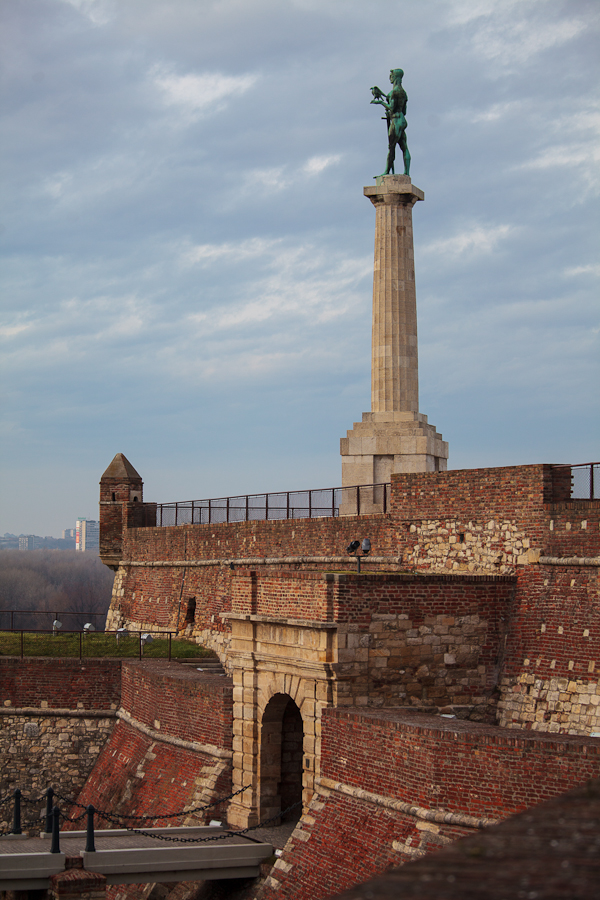
comments disabled
Kalemegdan – Belgrade Fortress
Published 14.01.2013. [13:46]
Belgrade Fortress is the core and the oldest section of the urban area of Belgrade and for centuries the city population was concentrated only within the walls of the fortress, thus the history of the fortress, until most recent history, equals the history of Belgrade itself. First mention of the city is when it was founded in the 3rd century BC as “Singidunum” by the Celtic tribe of Scordisci who had defeated Thracian and Dacian tribes that previously lived at the fort and around. The city-fortress was later conquered by the Romans, became known as Singidunum and became a part of “the military frontier”, where the Roman Empire bordered “barbaric Central Europe”. Singidunum was defended by the Roman legion IV Flaviae which built a fortified camp on a hill at the confluence of the rivers the Danube and the Sava. In the period between AD 378 and 441 the Roman camp was being repeatedly destroyed in the invasions by the Goths and the Huns. The legend says that Attila’s grave lies on the confluence of the Sava and the Danube (under the Fortress). In 476 Belgrade again became the borderline between the empires: Western Roman Empire and Eastern Roman Empire (Byzantine Empire), and the Slav-Avar State in the North.
The Byzantine Emperor Justinian I rebuilt the Fortress around 535. In the following centuries a fortress suffered continuous destruction under the Avar sieges. The Slavs (Serbs) and Avars had their “state union” north of Belgrade with the Serbs and other Slavic tribes finally settling in the region of Belgrade as well as the regions west and south of Belgrade in the beginning of the 7th century. The name Belgrade (or Beograd, in Serbian), which, not just in Serbian but in most Slavic languages means a “white town” or a “white fortress”, was first mentioned in AD 878 by Bulgarians. The Fortress kept changing its masters: Bulgaria during three centuries, and then again the Byzantines and again Bulgarians. The fortress remained a Byzantine stronghold until the 12th century when it fell in the hands of a newly emerging Serbian state. It became a border city of the Serbian Kingdom, later Empire, with Hungary. The Hungarian king Béla I gave the fortress to Serbia in 11th century as a wedding gift (his son married Serbian princess Jelena), but it remained effectively part of Hungary, except for the period 1282-1319. After the Serbian state collapsed after the Battle of Kosovo, Belgrade was chosen in 1404 as the capital of the principality of Despot Stefan Lazarević. Major work was done to the ramparts which were encircling a big thriving town. The lower town at the banks of the Danube was the main urban center with a new build Orthodox cathedral. The upper town with its castle was defending the city from inland. Belgrade remained in Serbian hands for almost a century. After the Despot’s death in 1427 it had to be returned to Hungary. An attempt of Sultan Mehmed II to conquer the fortress was prevented by Janos Hunyadi in 1456 (Siege of Belgrade). It saved Hungary from an Ottoman invasion for 70 years.
In 1521, 132 years after the Battle of Kosovo, the fortress, like most parts of the Serbian state, was conquered by the Turks and remained (with short periods of the Austrian and Serbian occupation), under the rule of the Ottoman Empire until the year 1867 when the Turks withdrew from Belgrade and Serbia. During the period of short Austrian rule (1718–1738) the fortress was largely rebuilt and modernized. It witnessed two Serbian Uprisings in the 19th century, the Great Serbian Migration in the 17th century, the Turkish Period. The fortress suffered further damages during the First and the Second world wars. After almost two millennia of continuous sieges, battles and conquests the fortress is today known as the Belgrade Fortress. The present name of Kalemegdan Park derives from two Turkish words, kale (fortress) and meydan (battlefield) (literally, “battlefield fortress”).